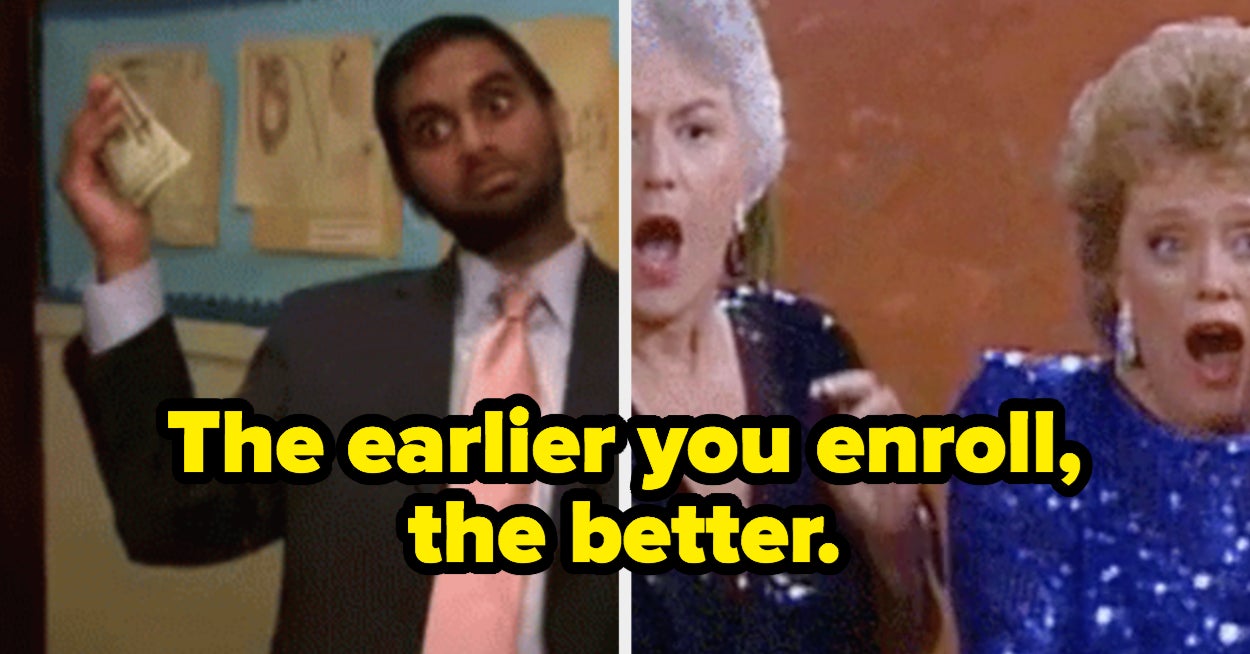
[ad_1]
When I got my first ~adult~ job, my parents told me to make sure I enroll in a 401(k) plan. I didn’t really know what it meant, and my parents — who never had 401(k)s of their own — could only explain that it was a retirement account.
CBC Television / Via giphy.com
While they were correct, there’s actually a lot more to it. And even though it might not be the most *exciting* topic, understanding how 401(k) plans work (especially when you’re young!) could help you bulk up your retirement fund over the course of your life.
Here are some very important things you should know about 401(k) plans:
1.
A 401(k) is an account offered through your employer, but you can still set one up if you’re self-employed.
The WB / Via giphy.com
A 401(k) retirement account is a benefit that many companies offer their employees. It allows you to take a portion of each paycheck and invest it for retirement. In other words, you’ve already contributed to your retirement fund before you’ve even paid rent and bills!
Some companies automatically enroll employees in a 401(k) plan, though most require employees to enroll themselves. But if your company doesn’t (or if you aren’t sure), you can double-check with your HR department and fill out the necessary forms to enroll. Alternatively, you can take a look at your pay stub. It’ll show whether or not you’ve made a 401(k) contribution. If your company doesn’t offer a 401(k) plan, you can set up an Individual Retirement Account (IRA). But more on that later.
And if you’re self-employed, you may be wondering how you could participate in a company-sponsored retirement account like this. According to Laila Pence, the president of Pence Wealth Management, you can set up a Solo 401(k) account. It’s based on the same idea of investing part of your income for retirement.
BTW, see what one writer learned about money after being self-employed for three years.
2.
You won’t pay taxes on your money until you withdraw it.
Discovery Channel / Via giphy.com
A traditional 401(k) is what you’d call a tax-deferred account. “The fact that the money gets to grow over 20 or 30 years on a tax-deferred basis is tremendous,” Pence said. So if the thought of taxes stresses you out, you can let go of that breath you’ve been holding in; you won’t have to worry about taxes for quite a while.
3.
And, there’s actually a really good reason behind the tax deferral.
NBC / Via giphy.com
If you’re working, chances are you’re currently paying quite a bit in taxes. If you were to cash out a 401(k) account right now, tax would take a huge bite out of your money. “The idea is that when you retire, you’ll be in a lower tax bracket because you won’t be working,” she said. “Therefore, you will pay less in taxes when you withdraw from your account during retirement.”
4.
There are two types of accounts: a traditional 401(k) and a Roth 401(k).
CBC Television / Via giphy.com
A traditional 401(k) is typically the account you have under your employer’s plan. Your pretax dollars get contributed to this account, and you pay taxes when you withdraw the money in the future. By contrast, a Roth 401(k) lets you contribute after-tax dollars; so when you make a withdrawal in retirement, you won’t have to pay taxes on the amount.
5.
You can choose how much of your paycheck you want to contribute to your 401(k).
ABC / Via giphy.com
“Most people contribute 5–10% of their paychecks toward their 401(k),” Pence said. There is no “rule” that tells you the minimum amount you need to contribute.
Even if you’re only comfortable setting aside 1% or 2% of each paycheck, making early investments in your retirement fund is so important because of compound interest. Time and interest are the dynamic duo at work here. You’ll earn interest on your contributions, and interest on top of that interest. And the earlier you start contributing, the more time you have to collect all those sweet, sweet gains.
There are lots of great compound interest calculators out there that you can play around with to really see the power of time and your money.
6.
The 401(k) is just the account. You can choose how you want to invest the money within your account.
CBS / Via giphy.com
Within your 401(k) account, you’ll find options for allocating your money. The full range of options depends on your company, but you can typically divvy up your cash among stocks, bunds, and mutual funds. All you have to do is log into the account and navigate to your asset allocation. You can make the changes that best suit your comfort level.
And BTW, you don’t have to be a total expert to allocate your money. Many accounts give you the option to invest in a target date fund, which is a fund that puts your money into diversified investments for you. They’re conveniently named to reflect your desired retirement year (so if you expect to retire in about 20 years, a 2040 fund can suit your needs). It’ll adjust itself over time to move from high-risk investments to lower-risk investments as you get closer to retirement. It can be a less stressful option if you don’t want to deal with rebalancing your portfolio yourself!
7.
Your employer might give you ~free~ money for your retirement account.
CBC Television / Via giphy.com
“When you have a 401(k) through your employer, they can offer to match your contribution,” Pence said. Basically, that’s FREE money! Just make sure you’re aware of the minimum amount you need to contribute in order to receive the match. According to Pence, “a company may, for example, offer a match if the employee contributes 5% [of their paycheck]. But, if the employee doesn’t contribute at least 5%, they won’t get the 5% match.” It would kinda suck to be left out of this ~free money~ opportunity just because you aren’t contributing just a little bit more to meet the match requirement; so if you can afford to do so, it’s definitely worth it.
If you’re not sure if your company offers a match, it’d be a good idea to hit up your HR department to ask. This way, you can be sure you’re cashing in on as much money as possible for retirement.
8.
When you leave your job, the money in your 401(k) DOES NOT just disappear.
Paramount Pictures / Via giphy.com
However, people often forget about their 401(k) money when they switch companies. The money and the account still exist; it doesn’t disappear into thin air when you leave your company.
According to Charles Schwab, you have a few options when it come to managing your 401(k) money when leaving a job. You can roll the money into your new employer’s 401(k) plan, or you can roll the money into a traditional or Roth IRA. But if neither of those suit your fancy, you can choose to leave the money right where it is. Or, you can just cash it out. Each option comes with its own set of advantages and disadvantages, so do some research to make sure you pick the option that best suits your needs.
9.
A 401(k) is NOT the same as an IRA account.
Bounce TV / Via giphy.com
Honestly, with all these account names flying around, it’s just too easy to get them mixed up. And, it’s even easier to think that the account names can be used interchangeably. The most basic difference between a 401(k) and an IRA is that a 401(k) is a company-sponsored retirement account, but an IRA is not. “A 401(k) is not an IRA,” Pence said. “An IRA is an Individual Retirement Account that you don’t need an employer to set up. You set it up on your own.”
Perhaps you’ve already heard of a Roth IRA. This is a type of individual retirement account you can set up without the help of your employer. Unlike with a traditional 401(k) account, you fund your Roth IRA with after-tax dollars. This means you won’t pay taxes on your withdrawals in retirement.
10.
And, it’s also NOT the same as a pension.
TV Land / Via giphy.com
If you thought they were the same, join the club. Employees have some control over their 401(k) accounts: They choose how much they contribute and how to allocate their funds. But with pensions, employees have no control over contributions.
“Some larger companies, especially in the past, have a pension plan,” Pence said. “It’s where the employer promises that the employee will receive a percentage of the income they had prior to retiring. It’s out of the employee’s control. But they have to stay at their company for a long time for the pension to be meaningful.” Just think of the pension plan as a “reward” for working at a company for several decades.
Nowadays, pensions are pretty rare in the private sector, but they’re still around in some union or government jobs.
11.
The earliest you can withdraw from a 401(k) is age 59 1/2. It’s possible to make a withdrawal before then, but there IS a penalty for withdrawing early.
FOX TV / Via giphy.com
Sometimes, life happens and you might decide to dip into your 401(k) account for some cash. But generally, you should avoid it. “Anytime you take money out of your 401(k) account before age 59 1/2, you will be taxed and have to pay a 10% penalty fee,” Pence said. So, since withdrawing from your 401(k) fund early can turn out to be more costly than expected, in most cases it’s best to keep your funds put until you retire (if you can).
12.
However, the penalty fee on early withdrawals can be waived under special circumstances.
ABC / Via giphy.com
You can make what’s called a hardship withdrawal to cover immediate and heavy costs. Only some expenses — like funeral expenses or some medical bills —qualify for a hardship withdrawal. And, according to Investopedia, you can only make this type of withdrawal if you don’t have any other assets you can use to cover your expense.
Once you qualify for a hardship withdrawal, that penalty fee will be waived — but you won’t be free from paying taxes on your withdrawal.
13.
You CAN borrow from your 401(k) account in the form of a loan — but some financial advisors don’t suggest it.
Paramount Pictures / Via giphy.com
A 401(k) loan might sound basically the same as an early withdrawal — but there’s a major difference. According to Investopedia, you must repay a 401(k) loan; you don’t need to pay back an early withdrawal.
When you take out a loan from your 401(k) account, you’re doing what’s called borrowing against yourself. In 2020, the government allowed people to borrow up to 50% of the value of their 401(k) account up to $100,000, according to Pence. This limit was increased due to the COVID-19 pandemic. “[This year], the limit goes back to normal, which is $50,000,” Pence said. “You have five years to pay it back unless you are using the funds to buy a home.” If you’re strapped for cash, this might sound appealing since you’re paying yourself back and still gaining interest.
However, you shouldn’t default to borrowing from your retirement account unless you’ve truly exhausted all other ideas. “It’s an option, but we don’t recommend it if you can get the money somewhere else. When you borrow your own money, you’re paying yourself back at a low interest rate. Your money won’t grow as much as it would if you had just left it alone.“
14.
There are contribution limits…but you definitely don’t have to meet them.
TriStar Pictures / Via giphy.com
According to Pence, if you’re under age 50, you can contribute up to $19,500 a year. And if you’re over age 50, you can contribute up to $26,000 (thanks to a cool thing called a ~catch-up contribution~). But hang on a second…
$19,500 is…a lot of money. If you make $15K a year (which is about an annual salary on the current federal minimum wage), that’s more than you’d be able to contribute. And if you make $50K, it’s still almost half of your salary. For many people, this number seems unobtainable since they have other living expenses — like rent, food, bills, and tuition. In fact, you probably won’t be able to support your needs and save this much unless you’re making close to $200K. So don’t feel like you’re doing “badly” if you can’t hit the contribution limit — some contribution is better than no contribution. It’s a limit, not a hard-and-fast rule that you have to save this much.
15.
It’s never too late to enroll in a 401(k) plan, but the earlier, the better.
Netflix / Via giphy.com
When it comes to your retirement account, time is your best friend. The longer you fund an account, the bigger it can grow. “What you contribute is great; but over time, what you EARN on that money is more powerful,” Pence said.
As the saying goes, the second-best time to start saving is now. So go forth and save for retirement!
If this sounds like music to your ears (and bank account), check out more of our personal finance posts.
[ad_2]
Source link





